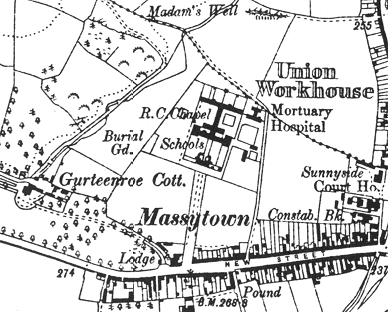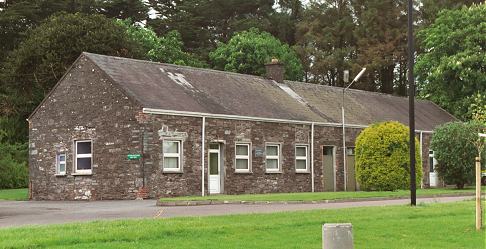Macroom, Co. Cork
Macroom (sometimes spelt Macroon) Poor Law Union was formally declared on the 20th December 1839 and covered an area of 304 square miles. Its operation was overseen by an elected Board of Guardians, 25 in number, representing its 16 electoral divisions as listed below (figures in brackets indicate numbers of Guardians if more than one):
Co. Cork: Aglish, Aghinagh, Aghabullogue (2), Ballyvournay (2), Cannavee, Clondrohid (2), Donaghmore (2), Inchageela or Eveleary (2), Kilcorney, Kilnamartyr, Macloneigh, Macroom (4), Magowney, Matehy, Milmurry (2), Ovens.
The Board also included 8 ex-officio Guardians, making a total of 33. The Guardians met on alternate Saturdays.
The population falling within the Union at the 1831 census had been 53,166 with divisions ranging in size from Macloneigh (population 1,520) to Macroom itself (5,353).
The new Macroom Union workhouse was erected in 1841-2 on a six-acre site at the north side of New Street to the west of Macroom. Designed by the Poor Law Commissioners' architect George Wilkinson, the building was based on one of his standard plans to accommodate 600 inmates. Its construction cost £8,359 plus £1,010 for fittings etc. The workhouse was declared fit for the reception of paupers on 1st October 1842, and received its first admissions on 13th May 1843. The site location and layout are shown on the 1904 OS map below.

Macroom workhouse site, 1904.
The buildings followed Wilkinson's typical layout. An entrance and administrative block at the east contained a porter's room and waiting room at the centre with the Guardians' board room on the first floor above.
The main accommodation block had the Master's quarters at the centre, with male and female wings to each side.
At the rear, a range of single-storey utility rooms such as bakehouse and washhouse connected through to the infirmary and idiots' wards via a central spine containing the chapel and dining-hall.

Macroom central spine, 2002
© Peter Higginbotham.
During the famine in the mid-1840s, a store was hired to accommodate 60 extra inmates. A forty-bed fever hospital and a mortuary were erected at the north-west of the workhouse. The workhouse had its own burial ground at the west of the site.
In May 1921, forty armed civilians attacked and burnt down the workhouse, after first removing the inmates to the infirmary. At about the same time a convoy of police was ambushed six miles west of Macroom with machine-guns being used by the rebels. This attack was evidently cover for the incendiarism.
The former workhouse site is now the home of Macroom Community Hospital.
Records
Note: many repositories impose a closure period of up to 100 years for records identifying individuals. Before travelling a long distance, always check that the records you want to consult will be available.
- Cork City and County Archives, 33a Great William O'Brien Street, Blackpool, Cork. Holdings include: Board of Guardian Minute Books (1884-1924); Indoor Relief Register (1916-21); etc.
Bibliography
- Kelleher, Con (2019) Macroom Union Workhouse, 1843-1921 (& Other Pieces).
- Crossman, V (2006) Politics, Pauperism and Power in Late Nineteenth-century Ireland
- Gray, P (2009) The Making of the Irish Poor Law, 1815-43
- O'Connor, J (1995) The Workhouses of Ireland
Links
- None.
Unless otherwise indicated, this page () is copyright Peter Higginbotham. Contents may not be reproduced without permission.


